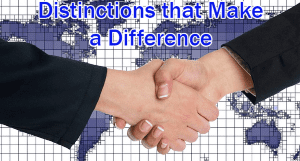Distinctions that Make A Difference: Social Entrepreneurism and Philanthropic Entrepreneurism
Author: Maurice A. Ramirez, DO, PhD
Sir Robert Baden-Powell, the founder of the Boy Scouts, instructs us to “Try to leave this world a little better than you found it.”
As healthcare professionals and healthcare entrepreneurs, you are all, by definition, social entrepreneurs. A social entrepreneur is a person or business that provides products or services that serve a public or societal good. Now it is arguable under this definition that almost all successful businesses serve a public or societal good, but for the social entrepreneur, that positive impact is as important or more important than the revenue stream their products or services generate. The social entrepreneur is not driven by the promise of profit, but by the possibility of relieving suffering, saving lives, or making the world a better place. They do not do good to make more money, they make money to do more good. In short, Social Entrepreneurs try to leave this world a little better than they found it.
But can Social Entrepreneurs maximize business success and good works to leave this world MUCH better than they found it?
As social entrepreneurs, you all have the means, motive, and opportunity to be philanthropic entrepreneurs as well. A philanthropic entrepreneur is a person or business that promotes the welfare of others through the generous donation of money to good causes. Philanthropic entrepreneurs not only make money to do more good, but they also donate to others to maximize the good that is done. Thus, the philanthropic entrepreneur is a social entrepreneur that supports others in a joint effort to leave the world MUCH better than they found it.
So how do Social Entrepreneurship and Philanthropic Entrepreneurship impact a company’s bottom line?
Multiple studies of consumer sentiment and its effect on consumer purchase choice and spending were published from 2019 to 2022, before and during the pandemic. The data and trends are very consistent across years and demographic groups.
- 78% of Baby Boomers (age 56-75) will choose products that are socially or environmentally responsible from a social entrepreneur. If the company also donates a portion of revenue or profit to related charities, this increases to 84%.
- Greater than 85% of those 18 to 55 years of age will choose products that are socially or environmentally responsible from a social entrepreneur. If the company also donates a portion of revenue or profit to related charities, this increases to 95%.
- This purchasing trend has increased by 8% each year since 2019 and is expected to continue to rise.
- More importantly, these consumers, regardless of demographic group, gender or age, are willing to pay 3% more for socially or environmentally responsible products and up to 15% more for responsible products from philanthropic companies.
How much should your company give?
There are several financial models for corporate giving, but two decades ago, Yvon Chouinard, founder of Patagonia, and Craig Mathews, founder of Blue Ribbon Flies, started a global movement among philanthropic entrepreneurs and corporations in general. These corporate leaders pledged 1% of gross revenue to charity and asked all other businesses to do the same.
Now donating 1% of gross revenue scares most start-ups and investors, but when you do the math, it is not that large a commitment and actually increases net profits.
Assume that the projected 3-year revenue of a start-up is $1 million dollars.
- 1% of gross revenue is $10,000 over three years.
- Now assume that the profit margin will be 15% over that same three years, or $150,000.
- The 3-year corporate donation totals 6.7% of gross profits.
However, since consumers will pay up to 15% more for socially or environmentally responsible products from philanthropic companies, the gross revenue can be as much as $1.15 million dollars.
- 1% of the larger gross revenue is $11,500 over three years
- The gross profit would therefore be $300,000, which is a profit margin of over 30%.
- With a profit margin exceeding 30%, donating 1% of gross revenue represents only 3.8% of gross profits.
Social entrepreneurship recruits more customers and increases consumer loyalty. Philanthropic entrepreneurship provides these same benefits and increases profits while doing the maximum good and leaving the world MUCH better than you found it.
About the Author:
Maurice A. Ramirez, DO, Ph.D., is a physician and innovator with over a quarter century of service in emergency medicine, artificial intelligence, computing, regulatory affairs, and disaster response. Dr. Ramirez is the recipient of the Lifetime Achievement Award in Disaster Medicine and Co-Founder of the High Alert Institute.
The High Alert Institute is a 501c3 not-for-profit educational public charity dedicated to providing disaster readiness education and resources to unserved and underserved communities, industries, and charitable organizations in an All Hazards, One Health, One Nature Framework. Learn more about the High Alert Institute at www.HighAlertInstitute.org










